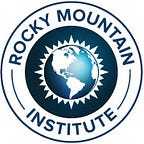From the Archives
Some artifacts from RMI’s rich history
By Laurie Guevara-Stone, writer/editor at Rocky Mountain Institute
A lot has happened over the past 35 years to make Rocky Mountain Institute what it is today. From our humble beginnings in the Lovins’s home to writing thought-provoking solution-oriented books, to creating new words and influencing policy, we have a lot to be proud of. We combed through our archives to pick out a few of the interesting projects and moments from RMI’s past.
Smaller Can Be Better
RMI’s book Small Is Profitable: The Hidden Economic Benefits of Making Electric Resources the Right Size, published in 2002, explains how the size of electrical resources affects their economic value. This Economist book of the year shows how distributed and decentralized electric resources can be up to 10 times more economically feasible than large power plants.
Rocky Mountain Bananas
Who knew you could grow bananas in the mountains of Colorado? RMI’s first office was based in a wing of Amory Lovins’s passive solar home, built in 1984 at an elevation of 8,000 feet. The home includes a 900-square-foot interior garden, which houses a tropical jungle including a banana tree that has produced 69 banana crops to date, leading the house to be affectionately known as the Banana Farm.
Mr. Lovins Goes to Washington
In 1977, President Jimmy Carter invited Amory Lovins into the Oval Office to discuss Amory’s recent Foreign Affairs article, “Energy Strategy: The Road Not Taken?” which discussed combining energy efficiency with a shift to renewable supply. In 2014, they met again, and President Carter said he found the article very helpful in forming his energy policy, the most coherently pro-efficiency-and-renewables policy to date at that time.
Getting Off Oil
Want to know how the U.S. can completely phase out oil? In 2004, RMI published Winning the Oil Endgame, cosponsored by the Pentagon, which detailed the first strategy for ending U.S. oil dependence, led by business for profit.
Getting Ready for EVs
In 2008, RMI formed Project Get Ready to help prepare for electric vehicle adoption. By 2011, Project Get Ready had partnered with 25 cities and regions throughout the U.S. as a trusted source of information on smart bidirectional charging infrastructure.
Lightweighting with Carbon
Those of you who have seen Amory in his carbon fiber “hat” know that in 1991, RMI invented the ultralight, superefficient Hypercar® concept. Based on lightweighting cars through the use of carbon fiber, often illustrated by Amory with a carbon fiber bowl (that can double as a “carbon cap”), the concept won the Nissan prize and helped launch modern hybrids and lightweighting.
The Bucky Dome Lives On
In 1982, inventor and visionary Buckminster Fuller offered to build one of his geodesic domes on the Windstar estate in Old Snowmass, Colorado, where RMI was soon to be headquartered. In the summer of 1983, weeks before construction was scheduled to start, Fuller died of a heart attack. In his spirit, a group of young architects and engineers, including RMI staff, built the Windstar biodome, which stood next to RMI’s offices until the 2015 move to the new RMI Innovation Center.
Low-Carbon Trucking
In 2009, RMI brought together a diverse group of people working in the trucking industry to figure out how to make this carbon-intensive industry more efficient. This Transformational Trucking Charrette led to the formation of the North American Council for Freight Efficiency (NACFE), an organization still working today to make truck fleets more fuel efficient.
RMI Retrofits an Icon
In 2008, RMI co-led the design of a deep energy retrofit of the Empire State Building. The retrofit saved two-fifths of the iconic building’s energy use with a three-year payback, and has since been scaled to more than 100 other buildings.
Reinventing Fire
Imagine no climate change, no oil spills, and no dirty air. In 2012, RMI published Reinventing Fire: Bold Business Solutions for the New Energy Era, which shows how a richer, fairer, safer world is not only possible but profitable. Based on RMI’s 30 years of research and work in the field, the book maps pathways for running a 158-percent-bigger U.S. economy in 2050 but needing no oil, no coal, and no nuclear energy, while saving $5 trillion.
Creating the Next Industrial Revolution
In 1999, RMI coauthored Natural Capitalism, which describes a new type of industrialism that is more efficient and profitable while saving the environment and creating jobs. It became a U.S. bestseller, and RMI launched a consulting practice based on its principles.
The Negawatt
How do you describe something that is not there? Fortunately, Amory Lovins saw a typo in a 1989 Colorado Public Utilities Commission report — negawatt instead of megawatt — and coined the term to describe electricity that is not created (i.e., efficiency). The word soon entered the English lexicon, and in 2003, was officially added to the Oxford English Dictionary.
